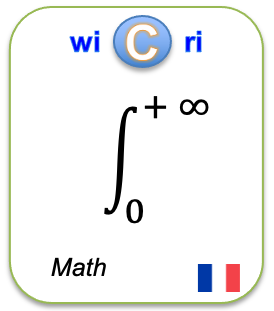The Bruhat Decomposition
Identifieur interne : 000040 ( Main/Exploration ); précédent : 000039; suivant : 000041The Bruhat Decomposition
Auteurs : Daniel Bump [États-Unis]Source :
- Graduate Texts in Mathematics [ 0072-5285 ] ; 2013.
Abstract
Abstract: The Bruhat decomposition was discovered quite late in the history of Lie groups, which is surprising in view of its fundamental importance. It was preceded by Ehresmann’s discovery of a closely related cell decomposition for flag manifolds. The Bruhat decomposition was axiomatized by Tits in the notion of a Group with (B, N) pair or Tits’ system. This is a generalization of the notion of a Coxeter group, and indeed every (B, N) gives rise to a Coxeter group. We have remarked after Theorem 25.1 that Coxeter groups always act on simplicial complexes whose geometry is closely connected with their properties. As it turns out a group with (B N) pair also acts on a simplicial complex, the Tits’ building. We will not have space to discuss this important concept but see Tits [163] and Abramenko and Brown [1].
Url:
DOI: 10.1007/978-1-4614-8024-2_27
Affiliations:
Links toward previous steps (curation, corpus...)
- to stream Istex, to step Corpus: 000352
- to stream Istex, to step Curation: 000352
- to stream Istex, to step Checkpoint: 000011
- to stream Main, to step Merge: 000040
- to stream Main, to step Curation: 000040
Le document en format XML
<record><TEI wicri:istexFullTextTei="biblStruct"><teiHeader><fileDesc><titleStmt><title xml:lang="en">The Bruhat Decomposition</title><author><name sortKey="Bump, Daniel" sort="Bump, Daniel" uniqKey="Bump D" first="Daniel" last="Bump">Daniel Bump</name></author></titleStmt><publicationStmt><idno type="wicri:source">ISTEX</idno><idno type="RBID">ISTEX:10353E807AAA1D4BE737E44A72C7C4793BD0D256</idno><date when="2013" year="2013">2013</date><idno type="doi">10.1007/978-1-4614-8024-2_27</idno><idno type="url">https://api.istex.fr/document/10353E807AAA1D4BE737E44A72C7C4793BD0D256/fulltext/pdf</idno><idno type="wicri:Area/Istex/Corpus">000352</idno><idno type="wicri:explorRef" wicri:stream="Istex" wicri:step="Corpus" wicri:corpus="ISTEX">000352</idno><idno type="wicri:Area/Istex/Curation">000352</idno><idno type="wicri:Area/Istex/Checkpoint">000011</idno><idno type="wicri:explorRef" wicri:stream="Istex" wicri:step="Checkpoint">000011</idno><idno type="wicri:doubleKey">0072-5285:2013:Bump D:the:bruhat:decomposition</idno><idno type="wicri:Area/Main/Merge">000040</idno><idno type="wicri:Area/Main/Curation">000040</idno><idno type="wicri:Area/Main/Exploration">000040</idno></publicationStmt><sourceDesc><biblStruct><analytic><title level="a" type="main" xml:lang="en">The Bruhat Decomposition</title><author><name sortKey="Bump, Daniel" sort="Bump, Daniel" uniqKey="Bump D" first="Daniel" last="Bump">Daniel Bump</name><affiliation wicri:level="2"><country xml:lang="fr">États-Unis</country><wicri:regionArea>Department of Mathematics, Stanford University, Stanford, CA</wicri:regionArea><placeName><region type="state">Californie</region></placeName></affiliation></author></analytic><monogr></monogr><series><title level="s">Graduate Texts in Mathematics</title><imprint><date>2013</date></imprint><idno type="ISSN">0072-5285</idno><idno type="eISSN">2197-5612</idno><idno type="ISSN">0072-5285</idno></series></biblStruct></sourceDesc><seriesStmt><idno type="ISSN">0072-5285</idno></seriesStmt></fileDesc><profileDesc><textClass></textClass><langUsage><language ident="en">en</language></langUsage></profileDesc></teiHeader><front><div type="abstract" xml:lang="en">Abstract: The Bruhat decomposition was discovered quite late in the history of Lie groups, which is surprising in view of its fundamental importance. It was preceded by Ehresmann’s discovery of a closely related cell decomposition for flag manifolds. The Bruhat decomposition was axiomatized by Tits in the notion of a Group with (B, N) pair or Tits’ system. This is a generalization of the notion of a Coxeter group, and indeed every (B, N) gives rise to a Coxeter group. We have remarked after Theorem 25.1 that Coxeter groups always act on simplicial complexes whose geometry is closely connected with their properties. As it turns out a group with (B N) pair also acts on a simplicial complex, the Tits’ building. We will not have space to discuss this important concept but see Tits [163] and Abramenko and Brown [1].</div></front></TEI><affiliations><list><country><li>États-Unis</li></country><region><li>Californie</li></region></list><tree><country name="États-Unis"><region name="Californie"><name sortKey="Bump, Daniel" sort="Bump, Daniel" uniqKey="Bump D" first="Daniel" last="Bump">Daniel Bump</name></region></country></tree></affiliations></record>Pour manipuler ce document sous Unix (Dilib)
EXPLOR_STEP=$WICRI_ROOT/Wicri/Mathematiques/explor/BourbakiV1/Data/Main/Exploration
HfdSelect -h $EXPLOR_STEP/biblio.hfd -nk 000040 | SxmlIndent | more
Ou
HfdSelect -h $EXPLOR_AREA/Data/Main/Exploration/biblio.hfd -nk 000040 | SxmlIndent | more
Pour mettre un lien sur cette page dans le réseau Wicri
{{Explor lien
|wiki= Wicri/Mathematiques
|area= BourbakiV1
|flux= Main
|étape= Exploration
|type= RBID
|clé= ISTEX:10353E807AAA1D4BE737E44A72C7C4793BD0D256
|texte= The Bruhat Decomposition
}}
|
| This area was generated with Dilib version V0.6.33. | |



